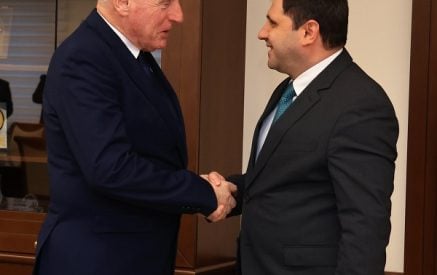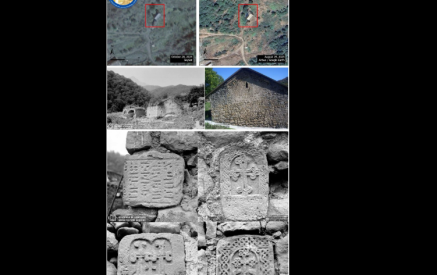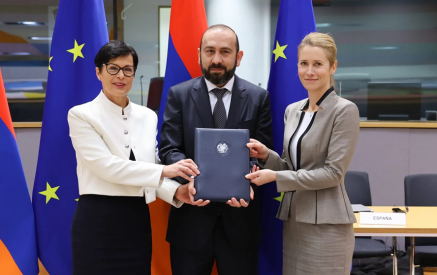There is an agreement to commence the construction works of the 3rd high-voltage line of electricity transmission between Armenia-Iran
A few days ago, the Iranian Ambassador to Armenia, Mohammad Raeisi, announced that they have 2 major projects with Armenia: the 3rd high-voltage line of electricity transmission and the Armenian-Iran railway. In the near future, one of the key issues of the agenda for the visit of Vice President of Iran will be the construction of the 3rd high-voltage electricity transmission line between Iran and Armenia.
On August 1, Prime Minister Hovik Abrahamyan had a telephone conversation with First Vice President of the Islamic Republic of Iran, Eshaq Jahangiri. They discussed a number of agenda issues of the Armenia-Iran relations, they discussed joint projects for the development of trade and economic relations and emphasized the intensity of activities of the Armenian-Iranian intergovernmental committee. Eshaq Jahangiri reassured that this year, they will make an official visit to Armenia. The above mentioned official release made it clear that already an agreement has been reached to begin construction of 3rd high-voltage electricity transmission line between Iran-Armenia. The latest Armenian-Iranian talks, in fact, produced certain results, if an agreement has been reached to launch the construction of the 3rd high-voltage electricity transmission line, which is a positive fact.
As for the railway, then it was promised by Serzh Sargsyan still on October 2, 2008 in his message to the people of Armenia and the National Assembly, “in the coming year the construction of the Iran-Armenia railway will be launched.”
Read also
In June, however, “Arminfo” agency published the interview with the President of the Russian Railways («Российские железные дороги») company, Vladimir Yakunin, in which the Russian official noted that the construction of the Armenia-Iran railway project is devoid of any effectiveness, the project has no future. “It is the same as you open a window in the wall to nowhere … to the wall of the neighboring house.” A few days later after the statement, the Minister of Transport and Communication Gagik Beglaryan, in his interview with “Freedom”, noted that Yakunin’s statement is driven from the interests of this Russian state company, while the railway has a vital importance for Armenia. “This is Mr. Yakunin’s subjective opinion that has nothing to do with reality. I understand him, this statement is driven from the interest of the company headed by him. This project is very important for our state and the people, and we should definitely do it.” Beglaryan did not explain what are the benefits of the Russian state company, of which the Armenia-Iran railway does not stem. First Deputy Minister of Transport and Communication, Arthur Arakelyan’s visit to Tehran last November resulted in signing an agreement, according to which, after launching of the railway construction in Armenia, Iran is committed to investing 400 million dollars for building the railway up to the border with Armenia.
In January, 2013, concession agreements were signed with Rasia FZE company registered in the United Arab Emirates, which made a commitment to build the Armenia-Iran railway with its own means, having the right to operate it for 3 years after the completion of the project. In December 2014, during the press conference with the journalists, Director of “South Caucasus Railway”, Victor Rebets stated that according to the agreement signed between the Ministry of Transport and Communication of Armenia, “Rasia FZE” company and them, after the construction of the Armenia-Iran railway, the “South Caucasian Railway” will have the primary right for the management of the railway.
Armenia’s railway, electricity distribution and the import and sale of the gas belong to a Russian state-owned company. By the agreement signed between the Government of Armenia and Russian Railways Company in February 2008, in Yerevan, the railway network, with its movable and immovable property, was granted to the Russian company for 30-year concession management, and the “South Caucasus Railway” company was established. As to what prospect expects to the Armenia-Iran railway under the openly negative sentiments of Russia, and to what extent Armenia’s local authorities are determined, time will tell. It is obvious that the railway project is not “a window opened in the wall”, but today, more than ever, a perspective project for Armenia.
The world opens “windows” for Iran
The US Secretary of State, John Kerry, is trying to convince the allies in the Middle East that the deal with Iran will make the region secure. He assured that all the countries of the region will become more secure.
Iran and the US are going to set up a joint Chamber of Commerce. As informed by the Head of Iran’s Chamber of Commerce and Industry, Mohsen Jalalpour, the US and commenced preparatory measures for the joint facility. Under the Iranian laws, Tehran can set up a Chamber of Commerce with the US after the setting up of a similar structure in the US. Jalalpour noted the US government authorities have not sent a request to visit Iran to negotiate on economic cooperation. In his words, such an initiative may become a subject for discussion for Iran’s President Hassan Rouhani to attend the UN General Assembly during his visit to the US.
And the EU is already mitigating the sanctions against Iran, officially approving the easing of a number of sanctions against Iran. The EU has removed two Iranian Oil Companies from the list of the sanctions. This is the first step after the signing of an agreement between Iran and the world superpowers on Iran’s nuclear project.
The European car industry is returning to Iran. Mercedes-Benz will purchase 30 percent of the shares the Iranian Diesel Engine Manufacturing located in Tabriz (IDEM, a diesel engine manufacturer), informed CEO of Iran Khodro Industrial Group, Hashem Yeke Zare. The latter informed that Iran and Mercedes-Benz will sign a 10-year agreement, under which Iran will produce trucks and buses. Prior to imposing sanctions by the West, Mercedes-Benz has been Iran’s main partner, and it is not surprising that the Company intends to open its office in Tehran in the next 2-3 months. Hashem Yeke Zare also informed that Mercedes-Benz intends to purchase 50 percent of the shares of Iranian Setar-Iran automobile manufacture and sign a 5-year agreement for the production of sedan cars. “The German Volkswagen automotive concern can also become Iran’s reliable partner,” he said, adding that in the next 3-4 months, Iran Khodro may also sign a contract with Germany’s Daimler AG for the production of luxury class cars. There is also information that the French Peugeot plans to set up a joint venture with Iran for the production of cars. The French Renault and Japanese Suzuki will also return to Iran.
As for the project to reach the Iranian gas to Europe, then the Head of the Department for External Affairs of the National Gas Company of Iran, Azizollah Ramezani said that Iran needs 10 billion dollars investment for bringing its gas to the European consumers. He said that given the positive sides of the nuclear deal entered between Iran and the “six”, Iran can export 25-30 billion cubic meters of gas a year to Europe. Ramezani mentioned the survey on potential gas suppliers to Europe conducted by the European Parliament and noted that Iran is the best candidate among the remaining 12 other potential gas suppliers to Europe. Note that according to the report of the European Commission, the following 13 countries may become an alternative to Russian gas in Europe as potential gas suppliers: the US, Iran, Qatar, Algeria, Nigeria, Norway, Libya, Azerbaijan, Turkmenistan, Mozambique, Australia, Iraq, as well as Israel and Cyprus.
To add also that Iran with its oil and gas reserves takes the first place in the world. Iran’s gas proven reserves amount to 34 trillion cubic meters, which is the 18 percent of the world’s proven gas reserve. Iran’s main markets are neighboring and Asian countries, recently announced the Head of the National Iranian Gas Export Company (NIGEC), Ali-Reza Kameli. He explained that the reason for it is the close location of these countries, low costs and rising consumption. Kameli also noted that Iran needs a 2000-4000 km long pipeline to export its gas to Europe destinations, while, for the neighboring countries, it suffices to build a 200 km long pipeline. He added that the obstacle to bringing Iranian gas to Europe is the fact that a number of countries will take a portion of this gas for their own consumption, which will reduce the profitability of such projects for Iran.
The fact that Iran can export its energy resources to Russia through Armenia and Georgia is already spoken for quite a long time. But there is no information about the discussions on this issue both with Iranian and Georgian sides. Armenia may become a transit country for transportation of oil and gas to Europe if Iran and Armenia reach an agreement with Georgia and Turkey, while the latter’s partner is the “brotherly Azerbaijan” rather than Armenia. One of the obstacles, of course, is the current tension on the border with Syria and Turkey, which will question the construction of the gas pipeline in terms of its secure operation.
Only the rumors that Iran will sell oil and gas to the West already resulted in the decline in oil prices, consequently, our neighbor Iran become a key player in the region that can change the snapshot not only in global markets but also become a major factor for the establishment of stability and security in the region.
EMMA GABRIELYAN























































